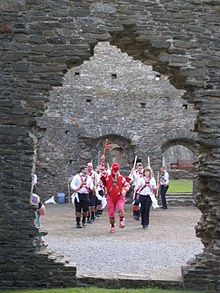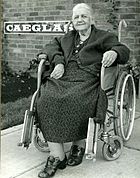- Nantgarw tradition
-
Nantgarw tradition is a style of Morris dancing from the South and Valleys regions of Wales, specifically the small village of Nantgarw. The style encompasses both handkerchief and stick dances. The dances call for eight dancers in four pairs.[1] There are now five dances in the Nantgarw tradition: Y Gaseg Eira (The Snow Mare), Hela'r Sgwarnog (Hunting the Hare), Ty Coch Caerdydd (Red House of Cardiff), Y Derwydd (The Druid) and Y Goron (The Crown).[2] They are most frequently performed by Cardiff Morris. The style was first put into dance notation by Dr. Ceinwen Thomas who wrote down what her mother, Margretta Thomas, could remember of the dances that had been danced locally when she was young.[3]
Contents
Etymology
The Nantgarw dances take their name from the village of Nantgarw in the county borough of Rhondda Cynon Taf where they are said to have first been performed.[4]:32
History
Origins
Catherine Margretta Thomas was born Catherine Margretta Davies in 1880[4]:31 in the village of Nantgarw. Her parents were Daniel and Hannah Davies.[5] As a child she enjoyed watching the local dances[6] as they were performed in an open space below Twyn Chapel in Caerphilly[4]:32 and at Nantgarw and Y Groes Wen.[6] Due to the hostility of the local churches to folk dancing, Margretta Thomas' own mother was not keen on her daughter going to see these dances, but Margretta was able to convince her father to take her along to witness the displays. The rise of Nonconformism in Wales meant that by the time Margretta Thomas was in her teens folk dancing had practically been eradicated in Nantgarw.[6]
The Welsh National Folk Dance Society
Dancing had died hard if inconsistently[6] by the time Margretta Thomas' daughter, Ceinwen Thomas, was born. But the influence of Nonconformism waned and by the time Ceinwen Thomas was attending school she was discussing the tradition of dancing in Nantgarw with her mother.[6] After Ceinwen Thomas had left college she met Walter Dowding of the Welsh National Folk Dance Society. She told him about her mother's recollections of folk dancing in Nantgarw. He put her in touch with Doris Freeman. Together Margretta Thomas, Ceinwen Thomas and Doris Freeman worked to notate the dance steps from the traditional dances that Margretta Thomas could remember.[6] These notes were then passed on to the Welsh National Folk Dance Society by Ceinwen Thomas.[7]
Revival
The United Kingdom experienced a revival in folk dancing and Morris dancing in the 1960s.[8] In Wales this meant, in part, a resurgence in interest in the Nantgarw tradition from sides who were looking for Welsh dances to add to their English ones.[9] Sides such as Cardiff Morris Men began piecing together these traditional dances from the notes that had been written down by Ceinwen Thomas.[10]:5 After these 'original' dances had pieced back together sides began to create more dances that were 'in the style of' the Nantgarw tradition.[11] Many of these new creations, such as Y Derwydd, are now held to be just as much a part of the Nantgarw tradition as the original dances.[12]
The Moves
Today there are five Morris dances that are commonly recognised as being a part of the Nantgarw tradition.[12]
Figures
The figures can be summarised as Foot Up, Corners Change, Top Hey, Bottom Hey and Circular Hey, with usually a distinctive verse figure unique to each dance.[10]:24[12]
Steps
There is double step throughout, except when 'chipping' (hopping in one spot whilst simultaneously rotating). The basic pattern is two double steps followed by four capers. There had been a tendency to truncate the second double step and leap straight into the capers, leading to a loss of balance and poise. The hand movements are straight up-and-down, with Adderbury-style circular movements at waist level for the capers. In the 'chipping' sequences in Caseg Eira and Hunting the Hare the arms are raised in turn and in time with the single stepping which accompanies it.[10]:28[12]
The Dances
Y Gaseg Eira (The Snow Mare)
 Cardiff Morris in Carmarthen finish a Nantgarw stick dance in distinctive style, by surrounding the mascot, Idris.
Cardiff Morris in Carmarthen finish a Nantgarw stick dance in distinctive style, by surrounding the mascot, Idris.
This handkerchief dance has a pattern entirely peculiar to itself and was the first Nantgarw dance to see the light of day with the Cardiff Morris. The name of the dance is a Welsh idiom for a very large snowball, and it is so named because at one point in the dance the hand waving movements resemble the movements of somebody rolling a large snowball.[12] This is the original Nantgarw dance and was being danced by 1974.[2]
Hela'r Sgwarnog (Hunting the Hare)
This is the first of three dances which conform to a standard pattern; which can, with a little care, be memorised and need, therefore, no calling. Like Caseg Eira it is a handkerchief dance.Current practise with the music is to use hornpipe time, which lends a lilt to the dance that some people find attractive.[12] It had been addd to the Nantgarw repertoire by 1984.[2]
Ty Coch Caerdydd (The Red House of Cardiff)
Sixteen sticks lend a certain weight to the stick bag, if not the proceedings. The sticks are held skiing-fashion (as in downhill, not slalom or cross-country) and are brought up in front of the face to clash.[12] It was being danced by 1984.[2]
Y Derwydd (The Druid)
Previously known as Y Gamel (The Camel) until it was renamed after the tune it is danced to. There are only eight sticks in this dance and no clashing except in the chorus. The dance pattern is identical to that of Hunting the Hare, even down to the half-heys in the chorus, except that the corner figures are completely replaced with Stars.[12] It was put together in 1991.[2]
Y Goron (The Crown)
This is a processional dance. Unlike the other dances which take place in one location this dance takes the dancers from one place to another.[12]
Practitioners
There are no hard and fast rules as to which Morris sides can perform dances from a tradition, but the original Nantgarw dance, Y Gaseg Eira, is considered to be a dance for the Welsh sides. Consequently it is often performed by the sides Isca Morris[13] and Cardiff Morris. It was members of Cardiff Morris who developed the modern Nantgarw dances[11] and so they are the most common performers of these dances.
Criticism
There has been skepticism expressed over the claims by Dr. Ceinwen Jones that the dances which her mother recalled were authentic and original Welsh dances reflecting a long and integral Welsh culture of folk dancing. The BBC Welsh Affairs Editor Vaughan Roderick wrote in a blog in 2009 that he doubted the history of these dances.[14] He questioned why only Margretta Thomas had any recollection of these dances being performed. He wrote that his great grandfather had been a minister in Nantgarw in the 1880s but had not seen these dances. He linked it to a romantic nationalist desire to create a longstanding tradition in Wales even if one had not existed in reality.
It has been pointed out that there are similarities between the Welsh Nantgarw style of Morris dance and the English Lichfield style of Morris dance.[15] It is known that there were potteries in Nantgarw and these were largely staffed by workers from Staffordshire where Lichfield Morris was danced.[10]
References
- ^ Blake, Lois (1966). "The Nantgarw Dances". Folk Music Journal 1 (2): 102–106. http://www.jstor.org/pss/4521744. Retrieved 15 September 2011.
- ^ a b c d e "Nantgarw tradition". Tiscali.co.uk. http://myweb.tiscali.co.uk/alroach/Nantgarw.htm.
- ^ "Nantgarw Fair Dances". dawnsio.com. Welsh National Folk Dance Society. http://dawnsio.com/en/dances/nantgarw-fair-dances/. Retrieved 16 September 2011.
- ^ a b c Lile, Emma (1999). A Step in Time: Folk Dancing in Wales. National Museum of Wales Publications. ISBN 0720004748. http://books.google.co.uk/books?id=GPMnOfeoIusC&pg=PA33&lpg=PA33&dq=nantgarw+margretta+thomas&source=bl&ots=EEPM9Xtctz&sig=8Gvw6XhXZ-WAccJ3cH4Rl_0UJ-Y&hl=en&ei=dllqTtLjK8nG8QOFm7At&sa=X&oi=book_result&ct=result&resnum=5&ved=0CDIQ6AEwBA#v=onepage&q=nantgarw%20margretta%20thomas&f=false.
- ^ "Catherine Margretta Thomas (Welsh)" (in Welsh). dawnsio.com. Welsh National Folk Dance Society. http://dawnsio.com/en/dances/nantgarw-fair-dances/catherine-margretta-thomas-welsh/. Retrieved 16 September 2011.
- ^ a b c d e f "Easter Course Address (English)". dawnsio.com. Welsh National Folk Dance Society. http://dawnsio.com/dawnsfeydd/dawnsfeydd-nantgarw/easter-course-address/. Retrieved 16 September 2011.
- ^ "Tom John's Rally / Comments". thesession.org. http://www.thesession.org/tunes/display/6420. Retrieved 16 September 2011.
- ^ Garland, Mike; Maher, John. "The Magic of the Morris". The Morris Ring. http://www.themorrisring.org/more/index.html. Retrieved 15 September 2011.
- ^ The Real Cardiff Morris. Myweb.tiscali.co.uk. Retrieved on 2011-09-27.
- ^ a b c d Blake, Lois. Ffair Caerffili and other Dances from Nantgarw. Cymdeithas Ddawns Werin Cymru.
- ^ a b Lascelles, Keith (13 March 2009). "Why is Morris Dancing always considered English? What about the Welsh?". Art Wales UK. http://www.arts-wales.co.uk/index.php?option=com_content&task=view&id=153&Itemid=52. Retrieved 16 September 2011.
- ^ a b c d e f g h i Cardiff Morris. Retrieved on 2011-09-27.
- ^ "Isca Morris Men Videos". Isca Morrismen. http://www.isca-morrismen.com/iscavideos.php. Retrieved 15 September 2011.
- ^ "Ffol-di-rol" (in Welsh). BBC. http://www.bbc.co.uk/blogs/thereporters/vaughanroderick/2009/06/ffoldirol.html. Retrieved 16 September 2011.
- ^ Everett, W.; F. C. Phillips (1957). "The Lichfield Morris". English Folk Dance and Song Society VIII (2): 103. http://www.greenmanmorris.org.uk/TheLichfieldMorris.pdf. Retrieved 15 September 2011.
Categories:- Dance
- Historical dance
- Traditions
- Wales
- Welsh culture
Wikimedia Foundation. 2010.


